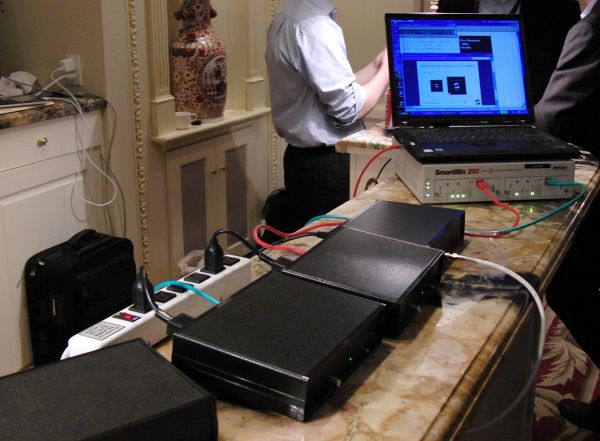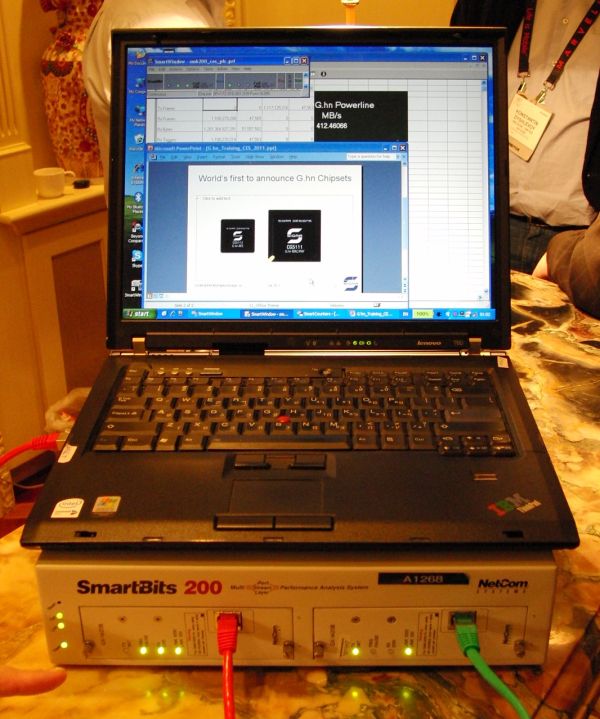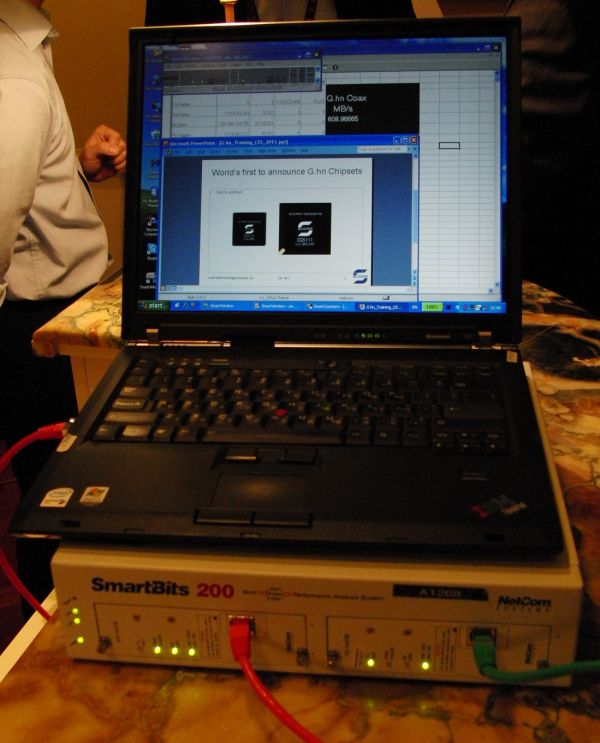G.hn Silicon Emerges from Vaporware Territory
by Ganesh T S on February 2, 2011 3:33 PM EST- Posted in
- Powerline Adapters
- G.hn
- HomePlug
At CES 2011, two companies demonstrated working silicon based on the G.hn standard. While Lantiq introduced the XWAY HNX100 series, Sigma Designs introduced their CG5110 chipset. I didn't have a chance to meet with Lantiq, and so, Sigma's CG5110 demonstration was the first time that I could really see G.hn in action.
Though both Lantiq and Sigma claim that their chipsets can be used over all three wired media (coax / phone lines / powerline), only Sigma seems to be backward compliant with HomePNA and HomePlug AV devices on the same network.
Sigma's Reuven Franco was kind enough to demonstrate the CG5110 in action over coax and also over a power strip. As can be seen in the photo of the setup I captured at the suite, the development board was hooked up to the Ethernet traffic generator. The actual application layer throughput was being measured in real time and updated on the spreadsheet.
Sigma's Demo Setup for the CG5110
Admittedly, the setup (power strip with no noise source and a plain coax cable) was not representative of real world conditions in general. However, it did end up giving us confidence in G.hn.
412 Mbps Over Powerline
608 Mbps Over Coax
Sigma also indicated that ClearPath Extreme (the next generation version of the ClearPath technology they had demonstrated on the CG2110) wasn't yet enabled on the CG5110. They were quite confident that the test results being demonstrated (as shown above) would be experienced by consumers in real world situations also.
Working silicon is a good first step for the G.hn supporters. However, a multitude of challenges still needs to be overcome. In particular, we are not aware of the cost of backward compatibility with HPAV and HPNA (for the CG5110). Other G.hn silicon vendors seem to have completely eschewed backward compatibility. With the existing HomePlug install base, this is still an area of concern for G.hn. Also, the extent of interoperability of the CG5110 will only be known if Sigma Designs volunteers its silicon for interoperability tests / products get to the consumers. It is also not clear if the performance of the CG5110 is limited by the silicon and protocol overheads associated with interoperability.
There is always a cost overhead associated with integrating support for different media types on the same chip. So, it looks like HomePlug devices will continue to be cheaper for powerline-only communication. In the service provider market, the extra cost is probably a minor factor compared to the installation cost savings, but it will definitely be a factor in the price sensitive retail market. In addition, service providers also want software maturity (carrier-grade). It remains to be seen how long that will take for the G.hn vendors, but getting working silicon out of the door is a good start.
As Sigma Designs stole the powerline show at CES 2011, what was Atheros in the HomePlug camp upto? We undertook a visit to their booth to find out.













18 Comments
View All Comments
sabot00 - Wednesday, February 2, 2011 - link
This seems to be a great alternative to Wi-Fi and Ethernet systems.I personally would take an Wi-Fi + Ethernet system for its power but I can see the appeal.
mcnabney - Thursday, February 3, 2011 - link
I would say that it is a very poor option to wifi.The key benefit is that there is no extension of the network outside of the home that an unscroupulous person could enter through.
Of course that eliminates the use of laptops (unless plugged into a specific location), cell phones and tablets - which is the direction the market is going. Not sure what kind of future in Powerline-based solutions since it ignores the growing segments of the market (unless you consider desktops to be a growing market).
derkurt - Sunday, February 6, 2011 - link
Actually, Powerline is often used in combination with Wi-Fi. More precisely, it is used to extend the network from the point of entry (i.e., DSL/cable modem) to some other place where an access point is connected to a powerline modem. This way, you can have a Wi-Fi network covering your entire home without having to use repeaters, which each cut throughput in half and double latency times, and also without having to install Ethernet, which can be impossible due to restrictions imposed by landlords or very expensive and aesthetically unpleasant in old houses, which do exist a lot in Europe.argosreality - Wednesday, February 2, 2011 - link
Interesting article and I always thought networking over powerlines was pretty logical but this article could use a bit more editing, I think. The first two pages have a quite a few things repeated and sometimes its hard to figure out where we're going with what.ganeshts - Wednesday, February 2, 2011 - link
The blurb on the front page and the 'Introduction' section sometimes carry the same information because search engines directly link you to the Introduction section. This is intentional. People arriving via search engines need to get a background on what we are talking about too :)villageworker - Wednesday, February 2, 2011 - link
As a tech. installer, mainly in residential setting, I use powerline networking technology to solve networking issues only as a last resort. Reason being its a black box. Powerline either works or doesn't. Any thoughts on how either of these chip guys are addressing the diagnostic tools issue?blokeuk - Thursday, February 3, 2011 - link
How this adapters slip thru the FCC net is beyond me, everybody knows that you cant transfer high frequency thru powerline normal cables thats why we have cat5 cat6 cables and so on, these units are wireless units that work on Shortware (HF radio amateurs , airtraffic controllers AM radio) for 100Mb and Shortwave and Ultra Shortwave (HF+VHF FM , TV and so on) for 1Gb so insted using an antenna they use Powerlines to transmit and the reciever is connected to the same antenna eg. the same powerline to receive the transmittion. PLA FDM is so wide it interfere with everything all across the bands.http://www.youtube.com/watch?v=utfUEEhmHYY
http://www.youtube.com/watch?v=9-Ge61BXsaQ
http://www.youtube.com/watch?v=0xAxvJILDIE
These are not electrical comunication devices they are radio comunication devices
If you cant install cat cables use normal 2.4Gh wi-fi instead Shortwave Wi-Fi
These frequencies are needed for Fire Truckes Police and emergency services please dont jam.
Thanks in advance and greetings from UK.
PS. Anand should do RF test on these devices when reviewing PLA.
lebarle - Thursday, February 3, 2011 - link
I don't know a lot about it, but I think blokeUK is making a very good point and would like to see what ANANDTECH can find out about it. All of our nifty electronic devices must share this limited spectrum. just looking at the first two videos listed in the blokeUK entry it would seem these powerline devices are VERY noisy and will interfere with my wireless house phones and yes maybe my neighbors police band reciever. If we raise a fuss here maybe the FCC can address this noise source before a lot of these devices get installed.Per Hansson - Thursday, February 3, 2011 - link
I can confirm your suspicionsI recently bought the Belkin Gigabit Powerline HD networking kit
It managed to do 5Mbps over my powerlines, an apartment built 1990.
When I turned on my FM radio there was an amazing amount of noise in the reception when I was transmitting data, less so when I was not transmitting data but still some pops and cracks in the reception.
When I unplugged the adapter the reception became perfect.
Next test was to run the powerline adapter from the apartment out into my garage, the speed now dropped to 1Mbps...
To my surprise though it managed to even interfere with the FM reception in my car!
The signal got way harder to receive, it did not crack and pop in the audio tho, but I think that may simply be due to the fact that the stereo in my car is much better at receiving a signal, and the fact that the car itself acts like a faraday cage...
To say the least I returned this "Gigabit" junk
epobirs - Thursday, February 3, 2011 - link
Those of us who have actually used powerline technologies know that blokeuk is completely wrong and those videos are nonsense. These devices are regulated by the FCC in the US. You know, the same FCC that also deals with the prospect of broadband over power transmission lines, with far greater potential consequence for RF comms. We simply haven't seen the same problems here because they were largely hammered out in advance.First of all, it's no great revelation that these are RF devices. It's little different than using coaxial lines in your home to transmit signals originally designed for over the air broadcast to multiple TVs. Guess what? Decades ago, when they started running coax through houses, ham operators took to whining and the FCC took on new responsibilities. A lot of gear on the market long ago is essentially illegal now. Today's spectrum is pretty well managed here. I work with a lot of RF geeks who are involved in emergency services support. None of them has voiced a complaint with powerline equipment sold in this market.
Wi-Fi is not an alternative for many and that number is growing. Wireless is shared spectrum and in many places the spectrum is severely overused. As most ISP are now supplying new customers with Wi-Fi routers there are whole neighborhoods where it has become essentially useless in large patches due to competing overlapping APs. At CES this year the problem was endemic. The head of Nvidia begged audience members during a keynote presentation to shut off the Wi-Fi portion of their phones because it was preventing him from running a demo using wireless. This is a growing problem that isn't getting much attention.
Powerline isn't going to interfere with your cordless phone. These are far more common than Ham gear in households and would quickly put any powerline vendor out of business if that was the case. Ham operators are pretty thin on the ground compared to teenage girls.
As mentioned by another commenter, a far bigger complaint, from an installer's perspective, is knowing how powerline will behave in a particular building. Wiring can vary wildly. In my own condo speeds are fine between nodes on the same floor but drop to a small fraction for a node upstairs trying to talk to one downstairs. Few SOHO IT guys have the electrician's knowledge needed to really say what is going on when they get no signal at all between nodes.